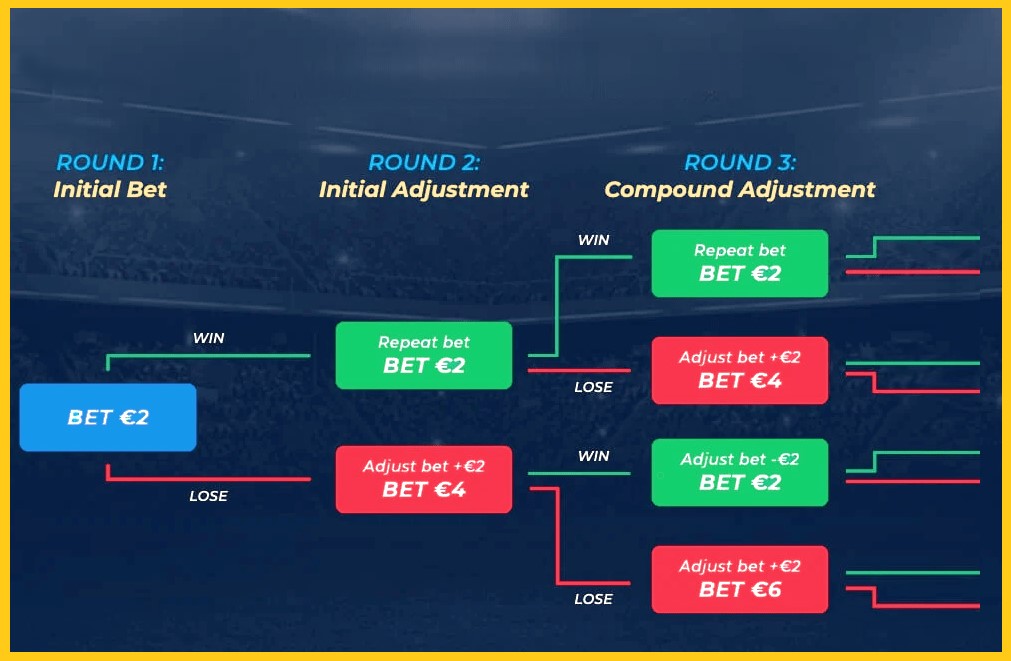
Looking for a straightforward yet effective solution to bet on sports? Consider the D’Alembert system. This famous betting system, named after the 18th-century mathematician Jean le Rond d’Alembert, is predicated on the theory that over time, wins and losses will balance out. In this article, we will explain how to use the D’Alembert system to wager on sports and provide advice for maximizing its effectiveness. The D’Alembert strategy is a useful tool for both novice and experienced gamblers.
What is the D’Alembert Betting System?
The D’Alembert betting system is a popular and reasonably straightforward betting strategy named after the French mathematician Jean le Rond d’Alembert of the 18th century. The strategy is commonly utilized in gambling games such as roulette and craps and is predicated on the theory that winnings and losses would eventually balance out over time.
The strategy works by increasing your bet by one unit following a loss and decreasing it by one unit following a win. This means that if you begin with a one-unit wager and lose, your subsequent wager will be two units. If you then win, your subsequent wager will be one unit. This procedure is repeated throughout the betting sequence. This is based on the assumption that you will eventually recoup your losses and turn a profit.
The simplicity of the D’Alembert betting system is one of its primary advantages. It is simple to comprehend and use, making it an excellent alternative for novices. In addition, the strategy is not as aggressive as other betting techniques, making it a decent option for people who choose a more conservative approach.
It is essential to remember, however, that the D Alembert strategy is not a guarantee of success. As with any betting strategy, there are inherent risks and restrictions.
As with any form of gambling, it is vital to create a budget, adhere to it, and stop when you reach your limit, regardless of whether you are winning or losing.
Overall, the D’Alembert betting system can be a helpful tool for people who wish to make informed decisions while betting on sports or participating in other forms of gambling. It is simple to use and can help lessen some of the inherent hazards of betting.
How does the D’Alembert Betting System work
The D’Alembert betting system is based on the premise that winnings and losses will eventually balance out over time. The system is named after Jean le Rond d’Alembert, a French mathematician from the 18th century who thought that the universe worked in balance or equilibrium.
The D’Alembert system functions by modifying your bet size based on the outcome of your previous wager.
After each round, you either raise or lower your wager by a predetermined amount, typically one unit. This means that if you begin with a one-unit wager and lose, your subsequent wager will be two units. If you then win, your subsequent wager will be one unit. This procedure is repeated throughout the betting sequence.

This is based on the premise that you will eventually recoup your losses and turn a profit. The concept is that if you lose a bet, you have a slightly increased probability of winning the next one and recouping your loss, and if you win a bet, you have a slightly decreased chance of winning the following one and making a profit.
Here is an illustration of the D’Alembert betting method in action:
- Start with a $10 wager.
- You lose the initial wager, so you boost the next wager by $10, to $20.
- You win the second wager, so you reduce your next wager by $10, putting it back to $10.
- You lose your third wager, so you boost your next wager by $10 to $20.
- You win the fourth wager, so you reduce your next wager by $10, putting it back to $10.
The D’Alembert betting system is a positive progression system, meaning that your bets grow after a loss and decrease after a victory.
In contrast, negative progression methods such as the Martingale system compel you to double your bets following a loss.
Basics of the D’Alembert
The D Alembert strategy is a common gambling approach based on the concepts of equilibrium and balance. The system is named after Jean le Rond d’Alembert, a French mathematician from the 18th century who thought that the universe worked in balance or equilibrium.
The technique functions by modifying your bet size based on the outcome of your prior wager.
After each round, you either raise or lower your wager by a predetermined amount, typically one unit. This means that if you begin with a one-unit wager and lose, your subsequent wager will be two units. If you then win, your subsequent wager will be one unit. This is based on the premise that you will eventually recoup your losses and turn a profit. It is a positive progression method that is less aggressive than other betting systems, making it suited for cautious players.
Here is a step-by-step instruction for using the D’Alembert betting system:
How to Use the D'Alembert Betting System in Betting
Choose a base stake, which represents the first amount you will wager
It’s advisable to start small and expand it as you get familiar with the system.
Decide on your unit size:
Your unit size represents the amount by which you will raise or lower your bet after each round. It is typically one unit, however, you may choose any quantity you desire.
Keep track of your bets:
The D Alembert system demands you to keep track of your bets, thus it is essential to have a detailed record of your winnings and losses.
Raise your wager following a loss:
If you lose a wager, you should increase your next wager by one unit. For instance, if your basic wager is $10 and your unit size is $5, your next wager should be $15 following a loss.
Reduce your wager after a victory:
If you win a wager, you should reduce your next wager by one unit. For instance, if your basic wager is $10 and your unit size is $5, your following wager should be $5 after a victory.
Continue to increase your wager following a loss and decrease it following a win.
Keep note of your victories and defeats and modify your wagers accordingly.
It is essential to establish a stop-loss limit, which is the maximum amount of money you are willing to lose. Stop betting whenever you exceed your stop-loss limit.
Establish a profit limit: it is essential to have a predetermined amount of money you wish to earn before quitting.
The D’Alembert betting system, like every betting strategy, carries with it some hazards and can only take you so far. After gambling, it is important to know your limits, keep to them regardless of whether you are winning or losing, and walk away when you have spent as much as you can afford to.
Example of the D’Alembert System, when Applied to Sports Betting
Here is an example of the application of the D’Alembert betting system to sports betting:
Consider that you wish to employ the D’Alembert strategie when betting on a football game. Your initial wager is $20, and your unit size is $5.
- You place a $20 wager on the home team to win as your initial wager.
- The home team loses, so you raise your next wager by $5 to a total of $25.
- You wager an additional $25 on the home team to win again.
- This time, the home team wins, so you reduce your next wager by $5 to $20.
- You wager $20 on the home team to win for a third time.
- Again, the home team loses, so you boost your next wager by $5, bringing the total to $25.
- You lay a $25 wager on the home team to win as your fourth wager.
- You cut your next wager by $5, bringing it back to $20 after the home team wins.
After a loss, you increase your wager and after a win, you decrease it. Additionally, you monitor your wins and losses and modify your wagers accordingly. You can also establish a stop-loss and profit limit. In this scenario, you would have lost a total of $5 and would have ceased betting after the fourth wager, when your profit maximum was met.
Notably, this is merely an illustration, and the D’Alembert betting system can be used for any sport and any sort of wager (moneyline, point spread, totals, etc.)
Variants of the D’Alembert System
There are numerous variants of the D’Alembert betting method that are utilized in various forms of gambling. Here are a few instances:
- Reverse D’Alembert: Reverse D’Alembert is often referred to as the “Anti-D’Alembert” system. Instead of increasing your wager following a loss and decreasing it following a victory, you do the opposite. This implies you increase your wager following a win and decrease it following a loss. The goal of this version is to maximize profits during winning streaks and limit losses during losing streaks.
- Modified D’Alembert: This variation is comparable to the original DAlembert system, but with a little modification. After each round, rather than raising or lowering your wager by a fixed sum, you raise or reduce it by a percentage of your current wager. For instance, you could increase your wager by 10% following a loss and decrease it by 10% following a victory.
- Fibonacci D’Alembert: This form combines the D’Alembert method and the Fibonacci sequence, in which each number is the sum of the two preceding numbers. You begin with a base bet, and following a loss, you combine the two prior wagers to decide your next wager. After a win, the subsequent wager is determined by subtracting the prior wager from the current wager.
- Progressive D’Alembert: This form is comparable to the original D Alembert system, but has bigger unit sizes. You could increase or decrease your wager by two or three units as opposed to one. This system is more aggressive and has the potential to generate greater income, but it also entails greater risk.
Is it worth using the D’Alembert System?
The DAlembert system applies to a variety of gambling forms, including sports betting, casino games, and horse racing. Whether or not the D’Alembert approach is worthwhile depends on your specific preferences and betting objectives.
The simplicity of the D’Alembert betting system is one of its primary advantages. It is simple to comprehend and use, making it an excellent alternative for novices. In addition, the strategy is not as aggressive as other betting techniques, making it a decent option for people who choose a more conservative approach.
Generally, the D’Alembert betting system can be a valuable tool for those who wish to make educated decisions when betting on sports or participating in other forms of gambling. It is simple to use and can help lessen some of the inherent hazards of betting.
The D’Alembert system is a popular and reasonably straightforward betting strategy based on the premise that winnings and losses will eventually balance out over time. Here are some advantages and disadvantages of adopting the D’Alembert betting system:
Pros and Cons of the D'Alembert System for Betting
The DAlembert system is simple to comprehend and use, making it an excellent choice for beginners.
The strategy is not as aggressive as some other betting systems, making it a decent option for people who choose a more conservative approach.
Reduces risk: By altering the quantity of your bet based on the outcome of your previous wager, the system can assist to reduce some of the dangers associated with gambling.
Positive progression: The D’Alembert system is a positive progression system, meaning that your bets grow after a loss and drop after a victory, so minimizing losses.
As with any betting system, the D’Alembert system comes with its own set of risks and restrictions, and it does not guarantee a profit.
Does not account for certain conditions: The approach is founded on the concept of balance and equilibrium, but does not account for the specific conditions of the game or the competing teams.
Does not account for certain conditions: The approach is founded on the concept of balance and equilibrium, but does not account for the specific conditions of the game or the competing teams.
Not appropriate for short-term wagering: The D’Alembert system is most suited for long-term wagering, as it is predicated on the premise that winnings and losses will eventually balance out over time.
Therefore, the D’Alembert betting system can be a beneficial tool for anyone seeking to make educated decisions while betting on sports or participating in other forms of gambling. Additionally, it is essential to be aware of its limitations and to include it in a larger betting plan.
FAQ
As it is founded on the concept of balance and equilibrium, the D'Alembert system can be employed in sports betting. Whether or not it will be successful relies on several variables, such as the game's specific conditions or the competing teams.
No assurance of winning can be found in using the D'Alembert betting system. There are dangers and limitations to using any betting method. Limiting some of the potential losses associated with gambling can be accomplished by adjusting the size of your bet based on the outcome of your prior gamble. Be mindful of its limits and use it as part of a bigger betting strategy.
The D'Alembert betting system is a generally safe strategy because it is not as aggressive as other betting methods, and it can help offset some of the dangers associated with betting by modifying your bet size based on the outcome of your previous wager.
The D'Alembert betting system's legitimacy is subject to the rules and regulations of the location in which it is utilized. While betting systems themselves do not break any laws, users must be cognizant of and by any applicable local rules and regulations before placing wagers. Keep in mind that gambling should be done in moderation and within the boundaries, you establish for yourself.
Last updated on 02 Feb 2023 - 20:05
















